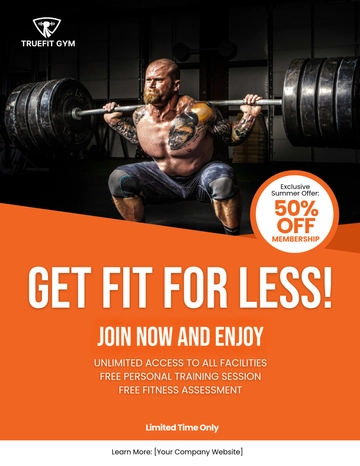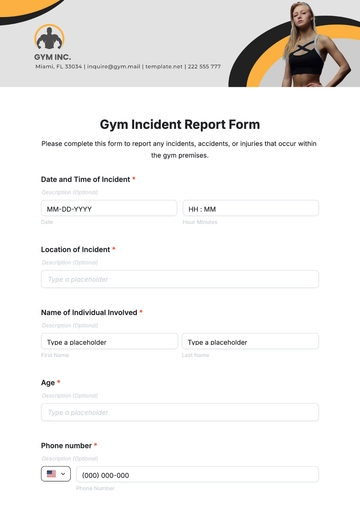Free Gym Financial Strategy

I. Executive Summary
A. Overview of the Gym
[Your Company Name], established in the bustling heart of downtown Anytown, stands as a premier fitness center celebrated for its cutting-edge facilities and bespoke fitness programs. Since its founding in [Year], [Your Company Name] has been on a consistent growth trajectory, successfully expanding its membership base and broadening its streams of revenue. This impressive expansion has been achieved through the introduction of inventive fitness classes and the provision of specialized personal training services, both of which underscore the center’s commitment to fostering a healthier, fitter community.
B. Purpose of the Financial Strategy
The Financial Strategy is designed to improve the overall financial performance of the organization by adopting a strategic approach to managing various financial aspects, including revenue growth, cost control, and profitability enhancement. This comprehensive plan functions as a detailed guide that informs and supports the decision-making processes of the organization, ensuring alignment with long-term goals for sustainability and growth. Moreover, a critical component of this strategy is to achieve and maintain a high level of satisfaction among members, which is considered essential for the organization's continued success and expansion opportunities.
C. Summary of Key Financial Goals
Increase total revenue by [00]% annually through targeted marketing efforts and expanded service offerings.
Reduce operating expenses by [00]% through efficiency improvements and cost-saving initiatives.
Maintain a profit margin of at least [00]% to ensure financial stability and reinvestment in facility upgrades and member benefits.
II. Financial Analysis and Assessment
A. Current Financial Position
Review of Financial Statements
Financial Statement | Amount ($) |
|---|---|
Total Revenue [Year] | [00] million |
Net Profit [Year] | [00] million |
Total Assets | [00] million |
Total Liabilities | [00] million |
[Your Company Name]'s financial statements for the fiscal year [Year] reflect a robust financial performance with total revenue of $[00] million and a net profit of $[00] million. The balance sheet shows total assets of $[00] million and liabilities of $[00] million, indicating a strong financial base.
Key Financial Ratios
Profitability: The current profit margin stands at [00]%, demonstrating efficient cost management and revenue generation strategies.
Liquidity: The current ratio of [00] indicates solid liquidity to meet short-term obligations comfortably.
Debt Management: With a debt-to-equity ratio of [00], [Your Company Name] maintains a conservative approach to financing, minimizing financial risk.
B. Analysis of Revenue Streams
Breakdown of Revenue Sources
Revenue Source | Contribution (%) |
|---|---|
Membership Fees | [00] |
Personal Training | [00] |
Classes and Workshops | [00] |
Membership fees constitute the majority of [Your Company Name]'s revenue at [00]%, followed by personal training services at [00]%, and classes/workshops at [00]%. This diversified revenue stream provides stability and growth opportunities.
Revenue Trends and Growth Analysis
Membership growth has averaged [00]% annually, driven by effective retention programs and targeted marketing campaigns.
Personal training revenue has increased by [00]% due to high demand for specialized fitness programs and quality training services.
Classes and workshops show seasonal fluctuations, with potential for growth through expanded offerings and increased utilization during peak times.
III. Financial Goals and Objectives
A. Revenue Targets
[Your Company Name] is setting a bold and ambitious goal to achieve a [00]% increase in total revenue by the close of the upcoming fiscal year. This objective will be attained through a multifaceted approach that includes implementing strategic adjustments to our pricing model, enhancing member engagement to foster stronger relationships and increase retention, and introducing a suite of new, innovative services designed to generate additional revenue streams. Each of these initiatives is part of a comprehensive plan to drive growth and ensure the financial health and sustainability of our company moving forward.
B. Cost Management Objectives
The gym is dedicated to reducing its operating expenses by a specified percentage through a series of strategic initiatives. These initiatives include renegotiating supplier contracts to obtain more favorable terms, optimizing energy usage to lower consumption and costs, and streamlining administrative processes to enhance efficiency and profitability overall.
C. Profitability Goals
It is imperative to sustain a profit margin that is no less than [00] percent in order to adequately finance continuing investments in various crucial areas. These areas include upgrading the facilities to enhance operational efficiency, maintaining and possibly improving the equipment to ensure it remains in optimal working condition, and investing in the development and training of employees to foster a skilled and motivated workforce. This strategic approach not only supports sustainable growth but also ensures the overall financial stability of the organization.
D. Cash Flow Objectives
[Your Company Name] strives to ensure that the revenue generated from its regular business activities exceeds its operational costs. This positive cash flow is intended to be consistently maintained in order to meet various financial commitments. These commitments include funding significant asset purchases to further the company's growth, servicing existing debt and meeting loan repayment requirements, and investing in strategic opportunities that align with the company's long-term goals. Importantly, [Your Company Name] endeavors to achieve all of these financial objectives independently, without the need to seek additional funds from external financing sources.
E. Return on Investment (ROI) Targets
The gym aims to achieve a return on investment of no less than [00] percent on its expenditures directed towards new equipment and technology upgrades within the upcoming three years. In pursuit of this goal, the gym will strategically utilize advancements in fitness technology and innovative equipment to improve the overall experience of its members and streamline its operational processes, thereby enhancing both member satisfaction and the efficiency of its day-to-day operations.
IV. Revenue Generation Strategies
A. Membership Acquisition and Retention
Membership Pricing Strategies
[Your Company Name] will implement tiered membership plans to cater to various customer segments, offering flexibility in pricing based on usage frequency and member preferences. Additionally, seasonal promotions and discounted rates for long-term commitments will be introduced to attract new members and enhance retention among existing ones.
Member Referral Programs
A structured referral program will be launched where current members receive incentives such as discounted membership fees or free personal training sessions for referring friends and family. This initiative aims to capitalize on word-of-mouth marketing and increase member acquisition through trusted recommendations.
Member Loyalty Programs
To foster loyalty, [Your Company Name] will enhance its loyalty rewards program with exclusive perks such as priority class registration, special event invitations, and personalized fitness assessments. These incentives are designed to strengthen relationships with members, reduce churn rates, and increase lifetime value.
B. Expansion of Revenue Streams
Enhancing Personal Training Services
[Your Company Name] plans to introduce specialized training programs tailored to specific demographics such as seniors, athletes, and individuals undergoing post-rehabilitation. These programs will be marketed as premium services, commanding higher rates and enhancing overall revenue from personal training.
Introducing New Fitness Classes
New fitness classes such as high-intensity interval training (HIIT), functional fitness, and mindfulness-based sessions will be added to the class schedule to appeal to diverse fitness interests and attract a broader demographic. The introduction of innovative and trending classes aims to increase class attendance and overall revenue from group fitness programs.
Upselling Merchandise and Add-On Services
To capitalize on member engagement, [Your Company Name] will expand its retail offerings by stocking high-quality fitness apparel, nutritional supplements, and wellness products. Strategic placement within the gym and exclusive member discounts will encourage purchases, boosting ancillary revenue and enhancing the overall member experience.
V. Cost Management and Operational Efficiency
A. Operating Expense Analysis
Fixed vs. Variable Costs
[Your Company Name] will conduct a thorough analysis of fixed and variable costs to identify opportunities for cost reduction without compromising service quality. Strategies include renegotiating contracts with suppliers, optimizing inventory management systems, and leveraging economies of scale through bulk purchasing.
Cost Reduction Initiatives
Initiatives such as energy-efficient lighting upgrades, water-saving measures, and waste reduction programs will be implemented to reduce utility expenses. Additionally, administrative efficiencies will be enhanced through digital automation of member management systems and streamlined operational processes.
B. Vendor Management and Negotiations
Supplier Contracts Review
A comprehensive review of vendor agreements will be undertaken to ensure competitive pricing, favorable terms, and adherence to quality standards. Vendor relationships will be strengthened through regular performance evaluations and proactive communication to address any supply chain disruptions effectively.
Cost-saving Opportunities
[Your Company Name] will explore opportunities to consolidate purchases and negotiate bulk discounts with preferred suppliers for gym equipment, maintenance services, and facility upgrades. This strategic approach aims to optimize procurement costs while maintaining product quality and service reliability.
VI. Investment in Facilities and Equipment
A. Equipment Maintenance and Upgrade Plan
Lifecycle Management of Equipment
A detailed maintenance schedule will be implemented to extend the lifespan of gym equipment and reduce unplanned downtime. Investment in preventive maintenance programs and regular inspections will ensure equipment reliability and minimize repair costs.
Budget Allocation for Equipment Replacement
[Your Company Name] will allocate a dedicated budget for equipment upgrades and replacements based on a lifecycle analysis. Priority will be given to critical equipment used frequently by members, with investments aligned with member feedback and technological advancements in fitness equipment.
B. Facility Upgrades and Renovations
Capital Expenditure Planning
Strategic capital expenditures will focus on enhancing member experience through facility upgrades such as locker room renovations, upgraded amenities, and the installation of cutting-edge fitness technology. These improvements aim to differentiate [Your Company Name] in the market and attract new members seeking a premium fitness experience.
Improving Member Experience through Facility Enhancements
Planned enhancements include expanding functional training areas, upgrading cardio machines with interactive displays, and introducing advanced audiovisual systems for immersive workout experiences. These upgrades align with market trends and member preferences for modern, high-performance fitness environments.
VII. Marketing and Sales Strategies
A. Marketing Budget Allocation
Digital Marketing Strategies
[Your Company Name] will increase its digital marketing budget to enhance online visibility through targeted advertising campaigns on social media platforms, search engines, and fitness-related websites. Content marketing strategies such as blog posts, video tutorials, and client testimonials will be leveraged to engage prospective members and promote gym offerings.
Local Advertising and Community Outreach
Strengthening ties with the local community, [Your Company Name] will sponsor local events, participate in health fairs, and collaborate with neighboring businesses on joint promotions. These initiatives aim to build brand awareness, foster community relationships, and attract new members from the surrounding area.
B. Sales Promotions and Campaigns
Seasonal Promotions
Seasonal promotions will be launched during key fitness periods such as New Year resolutions, summer fitness challenges, and holiday seasons. Special discounts on membership packages, personal training sessions, and group classes will incentivize sign-ups and boost revenue during peak demand periods.
Partnership Programs with Corporates or Local Businesses
[Your Company Name] will develop corporate wellness programs offering discounted membership rates and onsite fitness classes for employees of local businesses. Partnerships with hotels, spas, and wellness centers will be explored to cross-promote services and attract clientele interested in holistic health and fitness solutions.
VIII. Financial Risk Management
A. Identification of Financial Risks
Economic Downturns
[Your Company Name] recognizes the potential impact of economic downturns on discretionary spending and membership retention. Contingency plans will be developed to mitigate revenue fluctuations, including flexible membership options, targeted promotions during economic uncertainties, and prudent financial management to maintain liquidity.
Regulatory Changes
Monitoring regulatory developments in the fitness industry is critical to compliance and operational continuity. [Your Company Name] will stay abreast of health and safety regulations, data protection laws, and any changes affecting membership agreements or service offerings. Proactive adaptation of policies and procedures will ensure ongoing compliance and minimize legal risks.
Competitive Threats
Vigilant monitoring of competitor activities will inform strategic responses to competitive threats. Market research and benchmarking against industry leaders will guide pricing strategies, service enhancements, and differentiation tactics to maintain [Your Company Name]'s market position and attract discerning fitness enthusiasts.
B. Risk Mitigation Strategies
Diversification of Revenue Streams
To reduce dependency on any single revenue source, [Your Company Name] will diversify its offerings beyond membership fees to include robust personal training programs, specialized fitness classes, merchandise sales, and corporate partnerships. This diversified revenue approach spreads risk and enhances financial resilience against market fluctuations.
Insurance Coverage Review
Regular review of insurance policies, including liability coverage, property insurance, and business interruption insurance, will be conducted to ensure adequate protection against unforeseen events. Enhanced coverage for cybersecurity risks and member liability claims will safeguard [Your Company Name]'s assets and mitigate financial liabilities.
IX. Financial Reporting and Monitoring
A. Reporting Frequency and Formats
Financial performance will be monitored on a monthly basis, with comprehensive reports distributed to key stakeholders including management, investors, and the board of directors. Quarterly financial reviews will include detailed analysis of revenue trends, expense management, and key performance indicators (KPIs) to track progress towards financial goals.
B. Key Performance Indicators (KPIs) Tracking
Membership Metrics
Metrics such as membership growth rate, member acquisition cost (MAC), and member retention rate (MRR) will be closely monitored. A target of [00]% annual membership growth and a MRR of at least [00]% will guide membership acquisition strategies and retention initiatives.
Financial Health Indicators
Critical financial health indicators including profit margin, return on investment (ROI), and cash flow adequacy will be tracked. A profit margin target of [00]% and an ROI of at least [00]% on capital investments will ensure sustainable financial performance and support future growth initiatives.
- 100% Customizable, free editor
- Access 1 Million+ Templates, photo’s & graphics
- Download or share as a template
- Click and replace photos, graphics, text, backgrounds
- Resize, crop, AI write & more
- Access advanced editor
Make financial planning seamless with the Gym Financial Strategy Template from Template.net. This editable and customizable template includes a user-friendly AI Editor Tool, ideal for gyms seeking to optimize revenue, manage costs, and enhance profitability. Tailor strategies effortlessly to fit your gym’s unique needs and achieve financial success with ease.





























